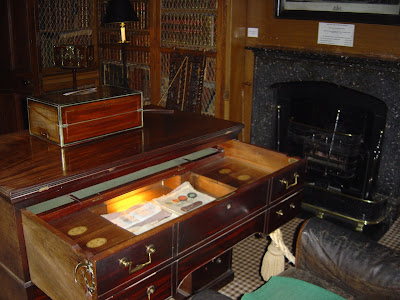Tam O' Shanter and The Brig O' Doon
You have to imagine it in the dead of night, the curve of the stone steady above the moving water, which unlaces the reflected shards of moonlight until they swim like the ghosts of fish. Blink once and they will be gone, blink again and a new school will have formed just a few feet away, swirling and diving, wild and joyful in the impossibility of their ever being caught.
Now hear the clop of the horse's hooves on the cobbles, the rattle of the bit in her mouth. See her hide shudder and the steam rise off her, and smell the combined waft of earth, hay, sweat and fear. Hear the manic cackle of a blood-thirsty witch, and see the bewildered look on the horse’s intoxicated rider, Tam O’ Shanter.
Of course they do make it, but not before poor Maggie loses some tail hairs to Nannie’s lunging grip.
There is such deep pleasure in being able to visit the very places that inspired some of Robert Burns’ greatest works. Located in the Alloway in Aryshire, where Burns was born, the famous Brig O’ Doon is such a romantic sight that it looks like something Burns drew from his mind and placed there in order to add drama to his tale.
I love Alloway so much that I am splitting my adventures there into more than one post. Thanks to Tam O Shanter, The Brig O’ Doon will never be seen as just another stone bridge. A little bit of magic happened here, and you cannot visit without walking up over the peak yourself, until you are across the water and safe from the spirits who might seek to follow you and do you harm.
If you are not content to see the bridge only by day, there is always the option of treating yourself to a stay at the stunning Brig O' Doon House Hotel, which is just up the road from the bridge. Then you really can go out by moonlight, look down at the rushing water, and play the story of Tam O’ Shanter over in your mind.
Ah, Tam! Ah, Tam! thou'll get thy fairin!
In hell, they'll roast thee like a herrin!
In vain thy Kate awaits thy comin!
Kate soon will be a woefu' woman!
Now, do thy speedy-utmost, Meg,
And win the key-stone o' the brig;
There, at them thou thy tail may toss,
A running stream they dare na cross.
But ere the keystane she could make,
The fient a tail she had to shake!
For Nannie, far before the rest,
Hard upon noble Maggie prest,
And flew at Tam wi' furious ettle;
But little wist she Maggie's mettle!
Ae spring brought off her master hale,
But left behind her ain grey tail:
The carlin claught her by the rump,
And left poor Maggie scarce a stump.
Now, wha this tale o' truth shall read,
Ilk man and mother's son, take heed:
Whene'er to Drink you are inclin'd,
Or Cutty-sarks rin in your mind,
Think ye may buy the joys o'er dear;
Remember Tam o' Shanter's mare.






























































